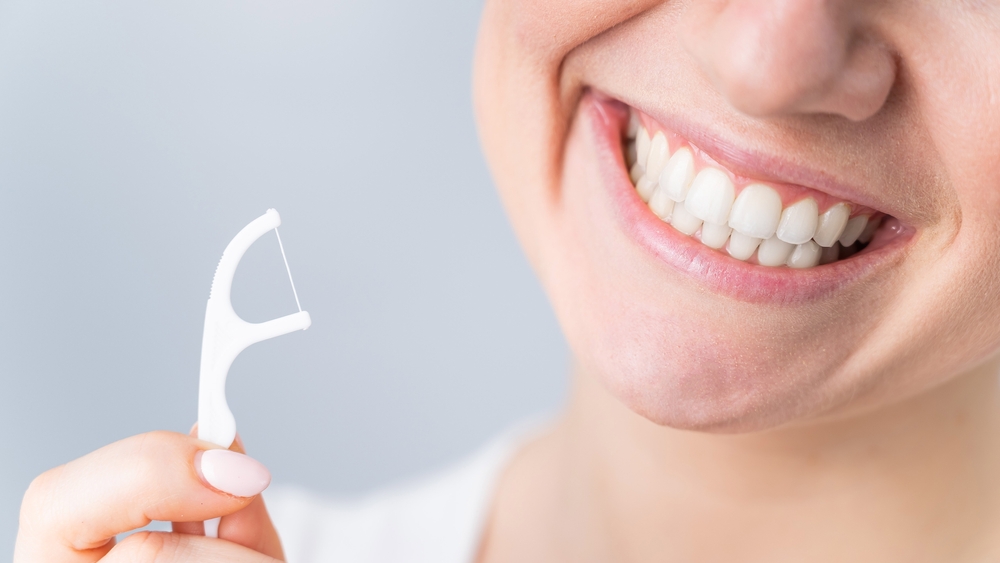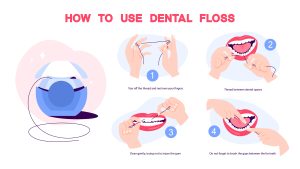

Imagine your teeth as a pristine white picket fence enclosing a beautiful garden that is your mouth. You would never let weeds grow and ruin the beauty of that fence, right? Flossing is like weeding this picturesque garden of yours, ensuring that pesky plaque and bacteria don’t creep in and cause havoc.
In this blog post, our dentists will guide you through the art of flossing to keep your smile as stunning as a spotless white fence – free from the “weeds” that threaten the well-being of your teeth and gums.
Flossing is an essential component of maintaining good oral hygiene. It can remove plaque from areas between teeth where a toothbrush can’t reach, helping to prevent tooth decay and gum disease. While there are various forms of floss available, finding a type of floss that works well for your unique needs and preferences is key to maintaining healthy teeth and gums.
Benefits of Flossing
When it comes to oral hygiene practices, brushing your teeth may be the first thing that comes to mind. However, flossing is just as crucial to maintaining good oral health.
When it comes to oral hygiene practices, brushing your teeth may be the first thing that comes to mind. However, flossing is just as crucial.
One benefit of flossing is preventing bad breath. Cavities and gum disease are caused by plaque build-up in the mouth, which can produce a foul odor. By diligently removing plaque between teeth with floss, you can minimize the bacteria in your mouth, creating fresher breath.
Another advantage of flossing is reducing your risk of developing gum disease. When left untreated, gum disease can lead to tooth loss and other serious health complications. Flossing removes food particles and bacteria from between the teeth that brush bristles can’t reach. This helps reduce inflammation in the gums caused by the buildup of harmful bacteria, reducing the likelihood of gum disease.
Regular flossing also helps prevent cavities, which occur when acid-producing bacteria damage tooth enamel. Brushing alone can’t remove all food particles or plagues in-between teeth, but using dental floss can help tackle this problem.
While some people might find flossing unpleasant or inconvenient, its advantages far outweigh any discomfort you might experience while doing so. Many also argue that brushing their teeth thoroughly eliminates the need for flossing altogether. However, the benefits of flossing are undeniable. Dental professionals recommend that people floss once a day to achieve the best oral health possible.
Preventing Plaque Build-Up
Plaque is a collection of harmful bacteria that can build up between teeth and along the gum line. Over time, if plaque is left untreated, it can lead to tooth decay and gum disease. When you use traditional dental floss or another interdental tool, you remove food particles that have become trapped between teeth throughout the day. This will reduce the possibility of plaque building up and causing dental issues.
Regular flossing reduces inflammation caused by gum disease while simultaneously slowing down the process of bacteria spreading inside your mouth, which leads to halting tooth decay and other dental issues.
Some are under the impression that plaque only builds up around their teeth and above their gums. In contrast, others believe that brushing alone can clean all bacteria from below the gum line, making an extra step like flossing inconsequential. These assumptions aren’t accurate because only removing food debris from above the gum won’t help prevent underlying infections caused by bacteria accumulated below the gum tissue.
An analogy to help explain this is when you wash dirty dishes with a sponge; it works great on plates when scrubbed effectively, but not so much in those thin crevices where food particles easily hide under them – just like how floss does.
Strengthening Gums
Have you ever noticed blood on your floss after using it? Bleeding gums are one of the first indications that your gums need strengthening. Weak or inflamed gums may lead to tooth loss in the long run. In some cases, eating certain foods can also cause gum sensitivity. For instance, spicy or acidic foods can irritate your gums and make them weaker, making them more susceptible to infections.

According to various studies conducted by oral health experts across the globe, flossing stimulates and strengthens your gum tissue. As you floss along the gum line, tiny wounds are created along the surface. These small injuries activate an immune response in the body that promotes tissue repair and healing. With regular flossing over time, this process can strengthen the gum tissue around the teeth.
Some people avoid flossing because they think it irritates their sensitive gums even more. However, avoiding flossing entirely won’t solve the problem. Instead, try using a softer type of floss or a Waterpik; these tools can help with cleaning between teeth while still being gentle on your gums.
Reducing Cavities
Cavities are caused by the buildup of plaque and bacteria on and around our teeth. When left unaddressed, this layer of plaque can lead to enamel decay that eventually causes a cavity. One of the most effective ways to prevent cavities is by flossing regularly. By removing food particles from between your teeth, flossing deprives the bacteria of a food source.
Let’s say you’re enjoying a caramel candy that gets stuck in between two teeth. Even if you brush regularly, some of the caramel may remain stuck there, which could contribute to the formation of a cavity over time. Regular flossing would remove those particles and minimize the risk of cavity formation.
Studies have shown that regular flossing can reduce tooth decay by up to 40 percent.
Some people argue that flossing isn’t worth the effort since they don’t see an immediate effect on their teeth or gums. However, good oral hygiene is all about prevention rather than reaction. You may not see any immediate benefits of flossing, but over time it could save you thousands of dollars in dental bills.
 Flossing Techniques
Flossing Techniques
Many people are unsure about the correct flossing techniques, leading to improper cleaning and the chances of damaging their gums.
One popular technique is called the C-shape method, where you curve the floss into a C-shape around each tooth and gently glide it up and down. This method helps clean both the tooth surface and the gum line. Another method is the sawing motion, where you move the floss back and forth while avoiding snapping it between your teeth. This helps remove food particles that may be stuck in tight spaces between your teeth.
When flossing, make sure that you use enough length of floss so that you don’t have to reuse any part of it. Reusing floss can lead to redistributing bacteria or even damaging your gums in severe cases.
Some people prefer using a water flosser over traditional dental floss because they find it easier to maneuver around their mouth without any difficulty. However, they might not be as effective as clinical studies suggest in removing plaque or reducing bleeding compared with traditional dental floss.
Proper Flossing Method
To make sure you’re getting the most out of your flossing routine, consider following the steps below:
Start by taking approximately 18 inches (or about an arm’s length) of dental floss and wrap it around your fingers, pulling the floss taut, leaving a few inches of floss for cleaning.
One common question is whether it’s better to start on the upper or lower teeth first while flossing. There’s no definitive answer, so it’s really up to you. However, it can be helpful to always start with the last tooth you want to clean first and continue moving forward toward the front teeth.
Remember that brushing shouldn’t replace flossing; they work together to provide complete oral hygiene care. So remember to give equal attention to both methods for optimal dental health.
Different Flossing Tools
Flossing is a crucial part of maintaining healthy teeth and gums. However, using traditional floss can be challenging for some people, which is why alternative flossing tools have become increasingly popular.
Floss Picks
Floss picks are the most common type of alternative flossing tool. They’re small plastic sticks with a single strand of floss attached to one end and a pointed pick on the other. Floss picks are perfect for people who find it difficult to wrap traditional floss around their lower teeth or need more precise control while cleaning between teeth. They’re also great for those who struggle with dexterity issues or have braces.
Interdental Brushes
Interdental brushes are tiny brushes designed to clean deeper between teeth and gums compared to traditional dental floss. They’re particularly useful for those who have larger gaps between their teeth or patients with orthodontic appliances. These brushes are typically easier to hold and maneuver than traditional floss. Plus, they come in various sizes to accommodate all tooth gap sizes.
Waterpiks
Waterpiks use a concentrated stream of water to remove plaque and food debris from between your teeth. Think of them as mini pressure washers for your mouth — they’re very effective when used correctly. Waterpiks require less manual dexterity but require electricity or a battery to function. While they’re very thorough when removing debris, Waterpiks don’t replace brushing entirely since they don’t remove buildup on the tooth’s surface.
Regardless of what tool you select, proper technique is essential.
Traditional Floss vs. Picks
- Traditional Dental Floss: Traditional dental floss consists of a single strand of thin nylon or plastic thread used to clean between teeth. This type of floss has been in use forever, and many people find it effective as it gets between teeth easier. It’s also cheaper than other alternatives. However, some may find wrapping the thin string around their fingers difficult or awkward depending on the angle between their teeth.
- Floss Picks: Floss picks already come set up with a piece of floss threaded through them, making them much easier to use and more accessible than traditional floss. Additionally, they sometimes have coatings or flavors to make the process more enjoyable for the user. The downside is that the pick can’t curve around the teeth as easily as regular floss and may not work well if you have misaligned teeth.
Ultimately, choosing the right tool comes down to individual preference. If you struggle with dexterity problems, it might be ideal for you to switch to an interdental brush, Waterpik, or floss pick rather than traditional floss. Alternatively, if you’re environmentally conscious or prefer not to contribute coffee-break trash, reusable metal dental threaders made from monofilament silken thread and veterinary bore brushes are great alternatives too.
Choosing the Right Floss for You
When it comes to choosing the right floss for your oral care routine, there are several factors to consider.
If you have large gaps between your teeth or want a more comfortable experience, you may want to consider using tape floss. Tape floss is wider and flatter than traditional string floss. On the other hand, if you have tight spaces between your teeth, you’ll need a thinner type of floss that can easily slide in between them.
For people who have sensitive gums or are prone to gum disease, unwaxed floss is an excellent option. Waxed options may fray and break apart during use, irritating your gums further. If you like flavored floss and prefer a fresh taste, then there are plenty of different flavors available on the market, such as mint and cinnamon floss.
Once you’ve chosen the right type of floss for your needs, it’s necessary to pick out the perfect material option based on safety and efficiency when cleaning your teeth.
Types and Materials of Floss
The traditional nylon range includes waxed and unwaxed dental floss. Waxed options are more slip-resistant and more robust than their unwaxed counterparts, making them an excellent option for people with tight spaces between their teeth or for people who have dental appliances such as braces. On the other hand, unwaxed floss is made up of nylon fibers that interweave, making it a good option if you have sensitive gums.
Ultimately, choosing the right type and material of floss for your individual needs can significantly impact your oral health routine. Consulting with your dentist can help you choose which product is best suited for your specific case. By regularly incorporating flossing into your daily routine along with brushing twice daily and attending regular checkups, you’ll be taking another step toward optimal oral hygiene.
Frequently Asked Questions
Are there different types of floss for different types of teeth?
Yes, there are different types of floss for different types of teeth. People have different dental needs, and some types of floss are more effective for certain situations than others. For example, people with tightly spaced teeth may find that waxed or slick floss is easier to use than regular floss, while those with wider spaces may prefer fluffy or woven floss. Additionally, people with sensitive gums may benefit from using specialized soft or gentle floss.
How often should someone floss their teeth?
According to the American Dental Association, individuals should floss their teeth at least once a day. This is because flossing removes food particles and plaque from between the teeth and along the gum line, helping to prevent tooth decay and gum disease.
However, some individuals may benefit from flossing more frequently than once per day. For example, individuals with braces or other dental appliances may need to floss more often to remove trapped food particles. Similarly, those with certain medical conditions (e.g., diabetes) may be at higher risk for gum disease and should discuss their individual flossing needs with their dentist.
Achieve Your Best Smile
Don’t let bad oral hygiene habits ruin your beautiful smile. By ensuring you floss at least once a day, you can boost your oral care routine and decrease your chances of developing unwanted dental problems, such as gum disease or tooth decay. Find your best smile today!


 Flossing Techniques
Flossing Techniques